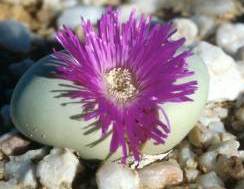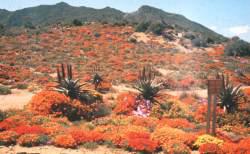Mesembryanthemaceae
Family: Mesembryanthemaceae (Aizoaceae) Class: Dicotyledonae (Angiosperms) Order: Caryophyllales
Family: Mesembryanthemaceae
Common names: mesembs, fig marigold, midday flower, ice plant (Eng.); vygie (Afr.)
Introduction
The Mesembryanthemaceae form a major and unique component of southern Africa's arid land flora. Succulent leaves, bright shiny-petalled flowers and hygrochastic fruit (capsules open when it rains) characterize the group. Mesembs are extremely diverse, particularly so in the Succulent Karoo Region, although they have a strong presence in the Fynbos. Some of the more primitive groups are almost entirely confined to Fynbos, suggesting that the Fynbos Biome may have acted as a mesic refuge for the semisucculent members of this group. Mesembs are the subjects of a huge trade in 'curiosity plants' among succulent collectors. They display features not seen elsewhere in the plant kingdom. The combination of minutism, mimicry and extreme succulence accounts for much of the variation in form and bizarre shapes that add to their appeal.


Description
Description
Mesembs are annual to perennial succulents, ranging from minute to compact and tufted to prostrate to decumbent; herbs, dwarf shrubs, subshrubs or shrubs, they are rarely spiny. The leaves are opposite, rarely alternate, simple, free at the base to almost completely united into single, conical to ± spherical bodies, often sheathing the stem. Their shape may be flat to 3-angled to cylindrical. All leaves may be similar (plant homophyllous) or different types of leaf pairs may be present (plant heterophyllous), members of a leaf pair may be similar (plant isophyllous) or dissimilar (plant anisophyllous), heterocellular (with distinct differences in cell sizes) or homocellular (cells of similar size), ephemeral to persistent, with or without bladder cells, sometimes tuberculate or punctate. The flowers are bisexual, regular, in cymose inflorescences, sometimes representing the entire plant, to solitary. The calyx is composed of 4 to 6 lobes, sometimes forming a short tube above the ovary. The corolla is composed of many more or less linear petals of staminodial origin, either free or shortly fused at the base. Stamens are numerous, often surrounded by few to many filamentous staminodes. The floral nectaries are either koilomorphic: represented by usually 4 or 5 shell-shaped depressions (in Mesembryanthemoideae), or lophomorphic: raised into a crested ring, continuous or broken into ± 5 crested glands (in some Ruschioideae), or flat, in the more primitive Ruschioideae. The ovary is inferior to half-inferior (in Mesembryanthemoideae), (3, 4)5(-25)-locular; placentas ranging from axile through basal to parietal; ovules usually many; stigmas usually as many as locules (seed chambers), subulate to filiform, sometimes fused at the base, sometimes plumose. The fruit is a loculicidal capsule that splits open when dry or mostly when wetted by means of hygroscopic expanding keels, the fruit is rarely schizocarpic (splits into separate carpels) with winged or nut-like mericarps, or it is fleshy and indehiscent. The seeds are more or less kidney-shaped, glossy to textured, black to brown to pale cream; in the seed, the embryo is curved around the perisperm (food reserve tissue).

Distribution and habitat
Distribution description
Mesembs comprise 127 genera and about 1 700 species, and account for 63% of southern Africa's succulent flora, and almost 10% of South Africa's Flora. The family Mesembryanthemaceae is comparable in size to the New World Cactaceae, also an arid area specialist group. Mesembs occur mostly in the southwestern parts of the African continent, from ± 16° N in Angola down to the Western Cape Province, extending well into the east over the central plateau of South Africa and reaching into Zimbabwe and Botswana. They dominate vegetation in the Succulent Karoo Region. This winter rainfall desert constitutes the world's only arid biodiversity 'hotspot' of the 25 recognized globally. The family is almost entirely endemic to southern Africa with only about 20 species occurring naturally elsewhere. Several species of Delosperma are found from northern Tanzania up to the Yemen and also in the Arabian Peninsula and Madagascar. A few species of Mesembryanthemum occur around the Mediterranean Sea, and most species of the genus Disphyma are found in Australia, New Zealand and the adjacent islands. The genus Sarcozona and some species of Carpobrotus are restricted to Australia, but species of Ruschia and Lampranthus may not be indigenous to Australasia. It is also not clear whether species of Malephora and Carpobrotus are recent introductions to South America, and the populations of Carpobrotus found along the west coast of North America were certainly introduced by man.

Derivation of name and historical aspects
History
The original name given to mesembs was Mesembrianthemum this name was chosen to describe the opening of flowers at noon. The spelling was later changed to Mesembryanthemum. Historically, the group of plants generally referred to as Aizoaceae have enjoyed fluctuating status in various systematic treatments. Although mesembs are most often classified in Aizoaceae, many taxonomists, particularly in South African herbaria, prefer to treat them as a separate family, Mesembryanthemaceae.
Ecology
Ecology
The uniqueness and success of the group is attributable to combinations of specialized morphological features that enable survival in arid and in semi-arid conditions. The mostly hygrochastic fruit capsules with rain-dispersed seed are diverse in form and serve taxonomically in the distinction between genera. Succulence and innovative water storage and saving mechanisms contribute to their resilience to drought. In contrast to their close relatives in Aizoaceae, mesemb flowers are characterized by whorls of bright-coloured petals originating through a "dedoublement" of staminodial primordia. Flowers are mostly adapted to insect pollinators.
Mesembs show a wide array of succulent morphologies, and succulence is an adaptation to survive seasonal drought in arid environments, although different strategies are evident. In succulent plants, water relations are optimized and prioritized against other factors such as carbon gain. Many utilize CAM photosynthesis, or are able to switch to CAM. Besides low and sporadic rainfall, other ecologically important factors in the life of mesembs include high irradiation, high temperatures, soil salinity and sandblasting. Low temperatures are thought to be a limiting factor in the distribution of most mesembs in the colder interior of southern Africa.
As mesembs are extremely popular amongst specialist succulent plant collectors, a number of them are threatened due to their removal from the wild e.g. Conophytum burgeri, as well as through the destruction of their habitats. Global climate change is seen as the greatest threat to the Succulent Karoo Region, due to the shifting of climatic belts, and the consequent destruction of their mega-niche.
Uses
Use
Their economic importance includes traditional uses in soap making, preserves, poultices and preparations with psychoactive medicinal properties, notably kougoed a preparation from Sceletium species. Carpobrotus edulis, known as the sour fig, is eaten as dried fruit or jam in the Western Cape. In addition, the astringent juice of Carpobrotus leaves is used medicinally for sore throats, bluebottle stings and fungal infections.

Growing Mesembryanthemaceae
Grow
The main use of mesembs is as garden plants. Their attractive flowers produce colourful displays in spring and early summer. The bokbaaivygie (Dorotheanthus bellidiformis) is a favourite, but many species of Lampranthus and Drosanthemum with their perennial shrubby habits are used in water-wise gardening. Species of Carpobrotus and Aptenia are used as garden plants worldwide. Among those previously described in the Plant of the Week series are Lampranthus aureus, L.affinis, L. multiradiatus and L.haworthii; Drosanthemum speciosum and D.floribundum; Frithia humilis and F.pulchra; Lithops olivacea, L.optica and Conophytum truncatum.
References
- Leistner, O.A. (ed.). 2000. Seed plants of southern Africa: families and genera. Strelitzia 10. National Botanical Institute, Pretoria.
- Smith, G.F., Chesselet, P., Van Jaarsveld, E.J., Hartmann, H., Hammer, S., Van Wyk, B-E., Burgoyne, P., Klak, C. & Kurzweil, H. 1998. Mesembs of the world. Briza, Pretoria.
Credits
Pascale Chesselet
Kirstenbosch Research Centre
March 2004
Plant Attributes:
Plant Type:
SA Distribution:
Soil type:
Flowering season:
PH:
Flower colour:
Aspect:
Gardening skill:
Special Features:
Horticultural zones






Rate this article
Article well written and informative
Rate this plant
Is this an interesting plant?
User Comments
Anna Maria, Netherlands
August 30, 2018 at 10:25 PMBeautiful plant
Login to add your Comment
Back to topNot registered yet? Click here to register.